display Citroen GRAND C4 PICASSO RHD 2017 2.G Owner's Guide
[x] Cancel search | Manufacturer: CITROEN, Model Year: 2017, Model line: GRAND C4 PICASSO RHD, Model: Citroen GRAND C4 PICASSO RHD 2017 2.GPages: 523, PDF Size: 11.96 MB
Page 115 of 523

113
Side blindsStorage wells
There are two storage wells under the rear
passengers' feet.
To open them, lift the cover at the cut-out.Fitted to the windows for the 2nd row seats, they protect
the passenger compartment from the sun's rays.
F Pull the tab A and anchor the blind on the hook B .
12 V socket
F To connect a 12 V accessory (maximum
power: 120 Watts), lift the cover and
connect a suitable adaptor.
Do not exceed the maximum power
rating of the socket (other wise there is a
risk of damaging your portable device).
The connection of an electrical device
not approved by CITROËN, such as a
USB charger, may adversely affect the
operation of vehicle electrical systems,
causing faults such as poor telephone
reception or inter ference with displays
in the screens.
3
Ease of use and comfort
Page 128 of 523
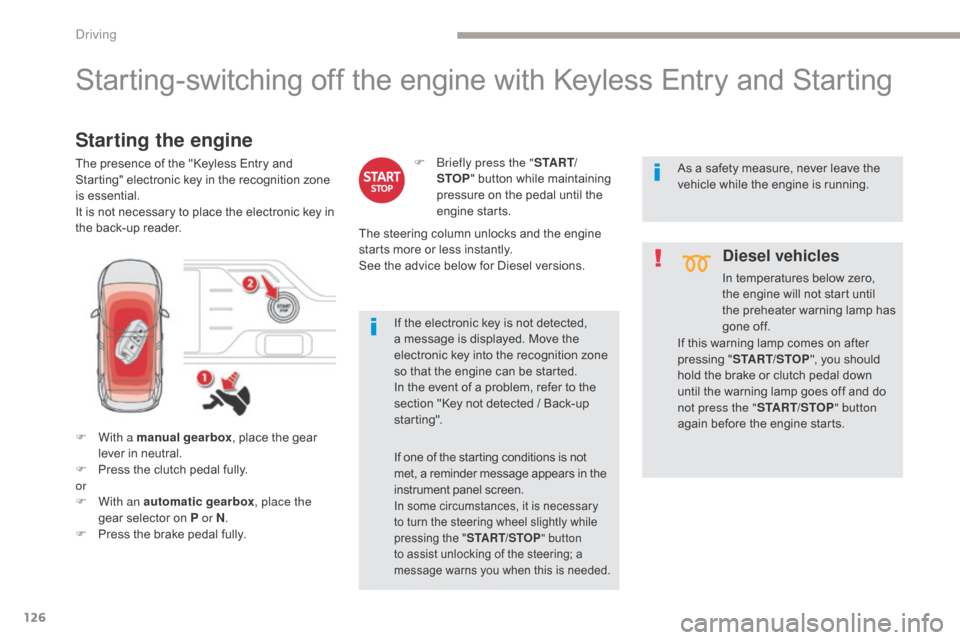
126
Starting-switching off the engine with Keyless Entry and Starting
F With a manual gearbox, place the gear
lever in neutral.
F
P
ress the clutch pedal fully.
or
F
W
ith an automatic gearbox , place the
gear selector on P or N .
F
P
ress the brake pedal fully.
Diesel vehicles
In temperatures below zero,
the engine will not start until
the preheater warning lamp has
gone off.
Starting the engine
The presence of the "Keyless Entry and
Starting" electronic key in the recognition zone
is essential.
It is not necessary to place the electronic key in
the back-up reader. If the electronic key is not detected,
a message is displayed. Move the
electronic key into the recognition zone
so that the engine can be started.
In the event of a problem, refer to the
section "Key not detected / Back-up
starting".F
B riefly press the "
S TA R T/
STOP " button while maintaining
pressure on the pedal until the
engine starts.
If one of the starting conditions is not
met, a reminder message appears in the
instrument panel screen.
In some circumstances, it is necessary
to turn the steering wheel slightly while
pressing the " START/STOP " button
to assist unlocking of the steering; a
message warns you when this is needed.
As a safety measure, never leave the
vehicle while the engine is running.
The steering column unlocks and the engine
starts more or less instantly.
See the advice below for Diesel versions.
If this warning lamp comes on after
pressing "START/STOP ", you should
hold the brake or clutch pedal down
until the warning lamp goes off and do
not press the " START/STOP" button
again before the engine starts.
Driving
Page 133 of 523

131
Label on door panel
Before leaving the vehicle, check
that the parking brake is applied: the
indicator lamps in the instrument panel
and the control lever must be on fixed,
not flashing.
If the parking brake is not applied, there
is an audible signal and a message is
displayed on opening the driver's door.
Never leave a child alone inside the
vehicle with the ignition on, as they
could release the parking brake.When towing, parking on a steep slope,
or if your vehicle is heavily laden,
turn the wheels towards the kerb and
engage a gear (with a manual gearbox)
or place the gear selector at position
P
with an automatic gearbox.
For towing, your vehicle is approved for
parking on slopes of up to 12%.
Manual operation
Application of the parking brake is confirmed
by illumination of the brake indicator lamp
and the
P indicator lamp in the control lever,
accompanied by the display of the message
"Parking brake applied".
Manual release
With the ignition on or the engine running, to
release the parking brake:
F
p
ress the brake pedal,
F
w
hile maintaining pressure on the brake
pedal, briefly push the control lever.
The complete release of the parking brake
is confirmed by the brake indicator lamp and
the
P indicator lamp in the control lever going
off, accompanied by the display of the message
"Parking brake released".
If you push the control lever without
pressing the brake pedal, the parking
brake will not be released and a
message is displayed.
Manual application
With the vehicle stationary: briefly pull the control lever.
Confirmation of the command is signalled by
flashing of the indicator lamp in the control
l eve r.
4
Driving
Page 134 of 523
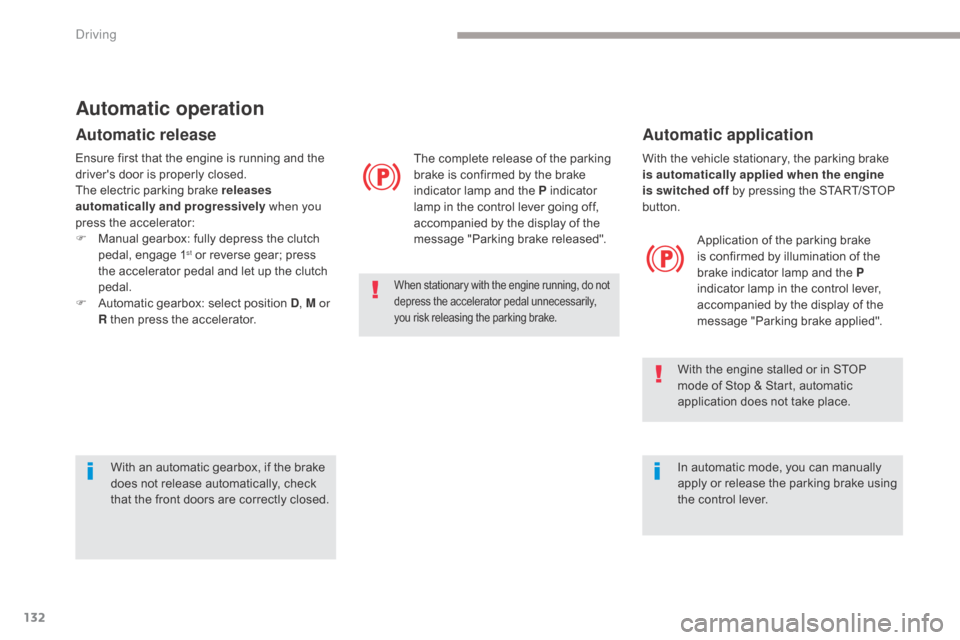
132
With the vehicle stationary, the parking brake
is automatically applied when the engine
is switched off by pressing the START/STOP
button.Application of the parking brake
is confirmed by illumination of the
brake indicator lamp and the P
indicator lamp in the control lever,
accompanied by the display of the
message "Parking brake applied".
With the engine stalled or in STOP
mode of Stop & Start, automatic
application does not take place.
In automatic mode, you can manually
apply or release the parking brake using
the control lever.
Automatic operation
Automatic release
The complete release of the parking
brake is confirmed by the brake
indicator lamp and the P indicator
lamp in the control lever going off,
accompanied by the display of the
message "Parking brake released".
When stationary with the engine running, do not
depress the accelerator pedal unnecessarily,
you risk releasing the parking brake.
Ensure first that the engine is running and the
driver's door is properly closed.
The electric parking brake releases
automatically and progressively when you
press the accelerator:
F
M
anual gearbox: fully depress the clutch
pedal, engage 1
st or reverse gear; press
the accelerator pedal and let up the clutch
pedal.
F
A
utomatic gearbox: select position D , M or
R then press the accelerator.
Automatic application
With an automatic gearbox, if the brake
does not release automatically, check
that the front doors are correctly closed.
Driving
Page 135 of 523
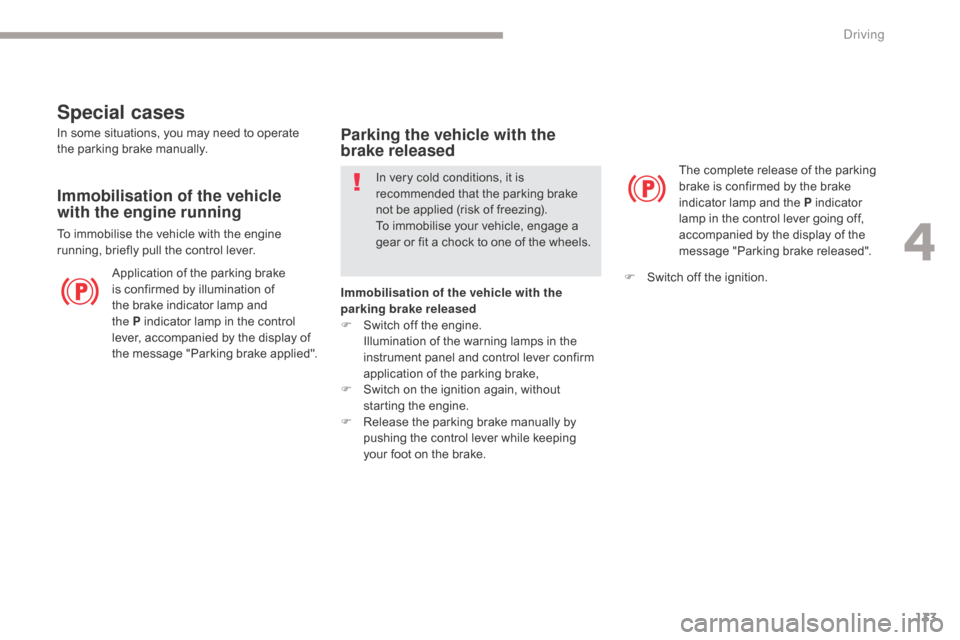
133
Special cases
Application of the parking brake
is confirmed by illumination of
the brake indicator lamp and
the P indicator lamp in the control
lever, accompanied by the display of
the message "Parking brake applied". The complete release of the parking
brake is confirmed by the brake
indicator lamp and the P indicator
lamp in the control lever going off,
accompanied by the display of the
message "Parking brake released".
In some situations, you may need to operate
the parking brake manually.
Immobilisation of the vehicle
with the engine running
To immobilise the vehicle with the engine
running, briefly pull the control lever.
Parking the vehicle with the
brake released
In very cold conditions, it is
recommended that the parking brake
not be applied (risk of freezing).
To immobilise your vehicle, engage a
gear or fit a chock to one of the wheels.
Immobilisation of the vehicle with the
parking brake released
F
S
witch off the engine.
I
llumination of the warning lamps in the
instrument panel and control lever confirm
application of the parking brake,
F
S
witch on the ignition again, without
starting the engine.
F
R
elease the parking brake manually by
pushing the control lever while keeping
your foot on the brake. F
S
witch off the ignition.
4
Driving
Page 136 of 523

134
Emergency braking
In the event of a failure of the main service
brake or in an exceptional situation (e.g. driver
taken ill, under instruction, etc.) a continuous
pull on the control lever will brake the vehicle.
Braking takes place while the control lever is
being pulled. It is interrupted if the control lever
is released.
The ABS and DSC systems provide stability of
the vehicle during emergency braking.
If the emergency braking malfunctions, the
message "Parking brake control faulty" will be
displayed.
If a failure of the ABS and DSC systems occurs,
signalled by the illumination of one or both
warning lamps in the instrument panel, then
stability of the vehicle is no longer guaranteed.
In this event, stability must be assured by the
driver by repeating alternate "pull-release"
actions on the control lever until the vehicle is
immobilised.The emergency braking should only be
used in an exceptional situation.
Repeat this procedure to reactivate automatic
operation.
Reactivation of automatic operation is
confirmed by the indicator lamp in the
instrument panel going off.
Deactivating automatic operation
In some situations, such as very cold weather
or towing (caravan, recovery), it may be
necessary to deactivate automatic operation of
the system.
F
S
tart the engine.
F
A
pply the parking brake with the control
lever, if it is released.
F
T
ake your foot off the brake pedal.
F
P
ush and hold the control lever in the
release direction for at least 10 seconds
and no more than 15 seconds.
F
R
elease the control lever.
F
P
ress and hold the brake pedal.
F
P
ull the control lever in the apply direction
for 2 seconds.
Deactivation of the automatic functions
is confirmed by illumination of this
indicator lamp in the instrument panel.
F
R
elease the control lever and the brake
pedal. From this point the parking brake can only
be applied and released manually using the
control lever.
Driving
Page 137 of 523
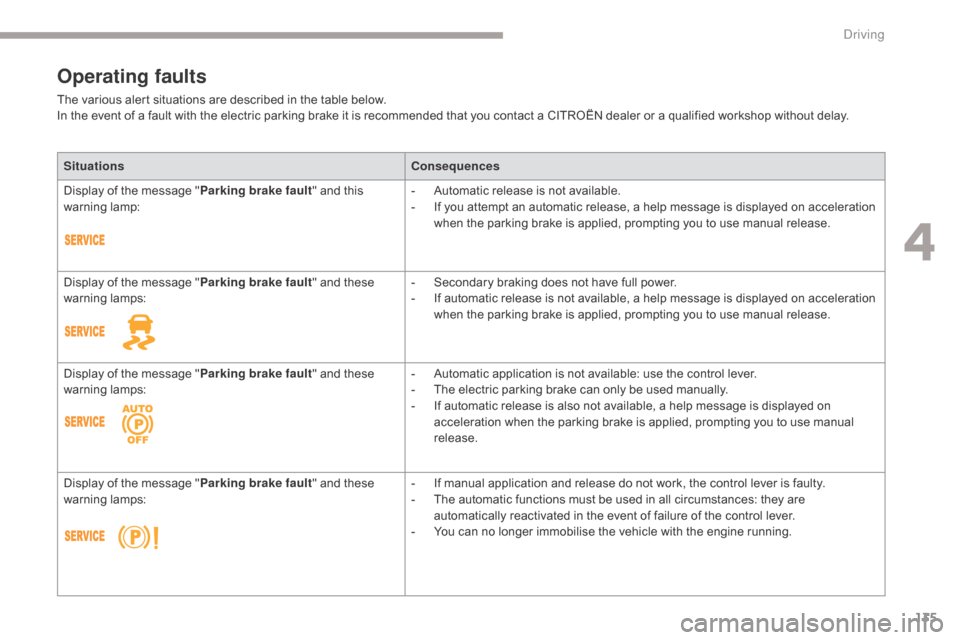
135
Operating faults
The various alert situations are described in the table below.
In the event of a fault with the electric parking brake it is recommended that you contact a CITROËN dealer or a qualified workshop without delay.Situations Consequences
Display of the message " Parking brake fault" and this
warning lamp: -
A
utomatic release is not available.
-
I
f you attempt an automatic release, a help message is displayed on acceleration
when the parking brake is applied, prompting you to use manual release.
Display of the message " Parking brake fault" and these
warning lamps: -
S
econdary braking does not have full power.
-
I
f automatic release is not available, a help message is displayed on acceleration
when the parking brake is applied, prompting you to use manual release.
Display of the message " Parking brake fault" and these
warning lamps: -
A
utomatic application is not available: use the control lever.
-
T
he electric parking brake can only be used manually.
-
I
f automatic release is also not available, a help message is displayed on
acceleration when the parking brake is applied, prompting you to use manual
release.
Display of the message " Parking brake fault" and these
warning lamps: -
I
f manual application and release do not work, the control lever is faulty.
-
T
he automatic functions must be used in all circumstances: they are
automatically reactivated in the event of failure of the control lever.
-
Y
ou can no longer immobilise the vehicle with the engine running.
4
Driving
Page 138 of 523

136
SituationsConsequences
Display of the message " Parking brake fault" and these
warning lamps: The parking brake is faulty, the manual and automatic functions may not operate.
When stationary
, to immobilise your vehicle:
-
P
ull and hold the control lever for about 7 to 15 seconds, until the warning lamp
comes on in the instrument panel.
If this procedure does not work, you should make your vehicle safe:
-
P
ark on a level sur face.
-
E
ngage a gear with a manual gearbox, or place the gear selector at position P
with an automatic gearbox.
-
I
f possible, fit a wheel chock.
Call on a CITROËN dealer or a qualified workshop.
Display of the message " Parking brake fault" and these
warning lamps: -
T
he parking brake does not have its full per formance to securely hold the vehicle
in all situations.
You should make your vehicle safe:
-
P
ark on a level sur face.
-
E
ngage a gear with a manual gearbox, or place the gear selector at position P
with an automatic gearbox.
-
I
f possible, fit a wheel chock.
Call on a CITROËN dealer or a qualified workshop.
The flashing of the P warning lamps on starting the vehicle indicates that the parking
brake is not correctly applied.
As soon as possible, stop the vehicle and try to completely release the parking brake,
using the control lever, with your foot on the brake pedal.
Display of the message " Battery fault" and this warning lamp: -
T
he state of charge of the battery is very low and requires immobilisation of the
vehicle in a safe place: engage a gear with a manual gearbox or fit a chock to
one of the wheels.
-
O
nce the battery is completely discharged, the controls do not operate: to
release the parking brake, call on a CITROËN dealer or a qualified workshop.
Driving
Page 142 of 523

140
+. Control paddle for changing up, to the right of the steering wheel.
F
P
ull the " +" paddle towards you to change up.
-.
C
ontrol paddle for changing down, to the
left of the steering wheel.
F
P
ull the " -" paddle towards you to change
down.
Steering mounted control paddles
The steering mounted control paddles
cannot be used to select neutral or to
select or come out of reverse. When you move the gear selector, the symbol
corresponding to its position is displayed in the
instrument panel.
P.
Pa
rk.
R.
R
everse.
N.
N
eutral.
D.
D
rive (automatic operation).
1 to 6. Gears engaged in manual operation.
-.
I
nvalid value in manual operation.
Displays in the instrument panelMoving off
F With your foot on the brake pedal, select
position P or N .
F
S
tart the engine.
If P is displayed in the instrument panel,
although the gear selector is in another
position, place the gear selector in
position P to be able to start the engine.
F
W
ith the engine running, press the brake
pedal.
F
S
elect automated mode (position D ),
manual mode (position M) or reverse
(position R ).
If you do not press the
brake pedal to come out of
position P , this warning lamp
If these conditions are not met, there
is an audible signal accompanied by a
message.
or symbol appears in the instrument
panel, accompanied by the message
"Place automatic gearbox in position
P",
flashing of P in the instrument panel
and an audible signal.
Driving
Page 143 of 523
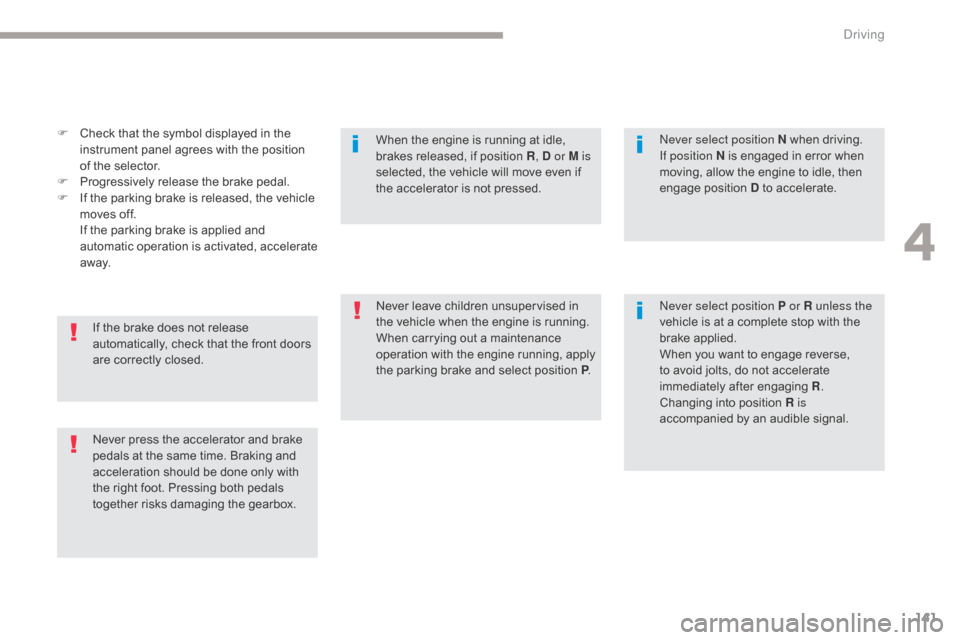
141
F Check that the symbol displayed in the instrument panel agrees with the position
of the selector.
F
P
rogressively release the brake pedal.
F
I
f the parking brake is released, the vehicle
moves off.
I
f the parking brake is applied and
automatic operation is activated, accelerate
away.
Never press the accelerator and brake
pedals at the same time. Braking and
acceleration should be done only with
the right foot. Pressing both pedals
together risks damaging the gearbox. If the brake does not release
automatically, check that the front doors
are correctly closed. Never leave children unsupervised in
the vehicle when the engine is running.
When carrying out a maintenance
operation with the engine running, apply
the parking brake and select position P
.Never select position P or R unless the
vehicle is at a complete stop with the
brake applied.
When you want to engage reverse,
to avoid jolts, do not accelerate
immediately after engaging R
.
Changing into position R is
accompanied by an audible signal. Never select position N when driving.
If position N
is engaged in error when
moving, allow the engine to idle, then
engage position D to accelerate.
When the engine is running at idle,
brakes released, if position R
, D or M is
selected, the vehicle will move even if
the accelerator is not pressed.
4
Driving